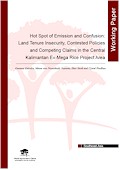| Working Paper Series |
 |
|
| Title | Hot Spot of Emission and Confusion: Land Tenure Insecurity, Contested Policies and Competing Claims in the Central Kalimantan Ex-Mega Rice Project Area | | Author | Gamma Galudra, Meine van Noordwijk, S. Suyanto, Idris Sardi and Ujjwal Pradhan | | Year | 2010 | | Publisher | World Agroforestry Centre - ICRAF, SEA Regional Office | | City of Publication | Bogor, Indonesia | | Series Number | Working Paper no 98 | | Number of Pages | 34 | | Call Number | WP0130-10 |
|
| Abstract: |
The Kalimantan Forests and Climate Partnership (KFCP) is a new initiative to explore and
hopefully demonstrate effective ways of reducing emission from peatlands as part of broader efforts to reduce emissions from deforestation and degradation (‘REDD’). Current negotiations seek consensus on the most effective methods and incentives for REDD in the local context. This study summarizes a rapid appraisal of the multiple claims of land tenure and use rights. Clarity on the bundle of rights and responsibility is seen as a basic prerequisite for success in REDD.
The area described here became a hot spot of conflict over land-use rights when the central government initiated the Mega Rice Project in 1995. This project did not fully recognize the land-use rights of existing local communities in that area, and brought in new stakeholders with claims derived from central authority. Consequently, conflicts erupted. Historically, the rights of the local community had been recognized and legalized during Dutch Colonial rule, at a time that external interest focused elsewhere. However, in the 1970s, an agrarian study conducted by the government found no evidence let alone proof of local community land rights in the area. Based on this study, the government issued logging concessions and then began a peatland conversion project without considering local community land-use rights as legitimate rights. When the Mega Rice Project was axed in 1999 to become the Ex Mega Rice Project, no government institution was in place to manage the area and coordinate. The local government initiatives encouraged oil palm investors and passed two local regulations on spatial land use planning, in 2002 and 2003. Consequently, several oil palm plantations commenced operation. After wider public debate and international attention for the high emission estimates for drained
peatland in 2007, the central government passed a decree that limited the operations of oil palm plantations and targeted the area as a pioneer for ecological restoration and emission reduction. This condition created uncertainty regarding who actually owned the rights to use the land. Multiple claims on land-use rights occurred not only between the government and local communities, but also among the local communities and between local and central government. Contestation over various aspects of rights pervaded through many entities and scales of government.
A business-as-usual approach (a top down approach by not taking into account existing institutions and practices and conflicts) to forest policies and governance cannot be an option if climate change mitigation is to be achieved by reducing emissions from this ex-forest landscape that still contains substantial tree cover and ecological value. REDD cannot be
effective in such a peat dome landscape unless a governance and collective action scheme emerges that acknowledges rights and claims that derive from the various phases of local history. International development and recognition of REDD mechanisms must include tools to monitor the implementation of governance and other reforms necessary for the recognition of local rights, negotiated relations and rights, along with incentives t
o support an alternative development pathway. |
|
|
Download file(s): Click icon to download/open file.
|
| |
File Size |
Description |

|
801 KB |
Softcopy |
|
|
GRP 6: Developing policies and incentives for multifunctional landscapes with trees that provide environmental services
|
| Viewed in 2467 times. Downloaded in 892 times. |